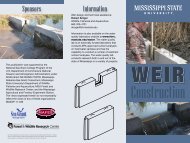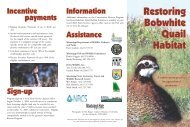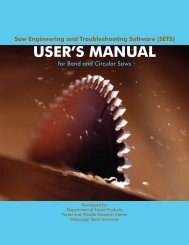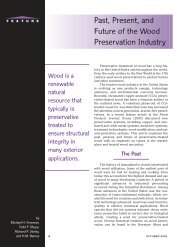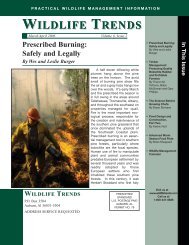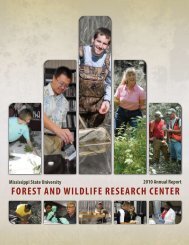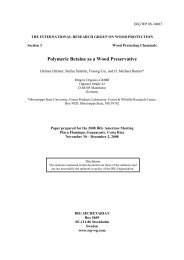Mid-contract Management Opportunities on Conservation Reserve ...
Mid-contract Management Opportunities on Conservation Reserve ...
Mid-contract Management Opportunities on Conservation Reserve ...
Create successful ePaper yourself
Turn your PDF publications into a flip-book with our unique Google optimized e-Paper software.
Wildlife Trends - Practical Wildlife <str<strong>on</strong>g>Management</str<strong>on</strong>g> Informati<strong>on</strong><br />
the 10-year life of the <str<strong>on</strong>g>c<strong>on</strong>tract</str<strong>on</strong>g>, in a process<br />
known to ecologists as successi<strong>on</strong> (see Figure<br />
2). Annual weed communities, characterized<br />
by grasses, annual forbs, legumes, and bare<br />
ground, dominate newly established CRP<br />
fields. These annual communities are shortlived,<br />
lasting <strong>on</strong>ly <strong>on</strong>e to two growing seas<strong>on</strong>s.<br />
CRP fields dominated by fescue provide low quality<br />
wildlife habitat.<br />
8<br />
Wetlands<br />
2%<br />
Existing Trees<br />
30%<br />
CRP in the Southeast<br />
Buffer Practices<br />
12%<br />
New Hardwood<br />
10%<br />
Rare & Declining<br />
0%<br />
Foodplot<br />
0%<br />
New L<strong>on</strong>gleaf<br />
6%<br />
Gradually, annual plants are replaced by perennial<br />
forbs, grasses, and eventually, woody<br />
plants. These changes in vegetati<strong>on</strong> compositi<strong>on</strong><br />
are also accompanied by changes in vegetati<strong>on</strong><br />
structure. As the plant community ages,<br />
bare ground declines, litter accumulates, and<br />
vegetati<strong>on</strong> density increases. In the Southeast,<br />
with l<strong>on</strong>g growing seas<strong>on</strong>s, warm temperatures,<br />
and high rainfall, natural successi<strong>on</strong> progresses<br />
rapidly.<br />
Successi<strong>on</strong> also occurs in CRP pine plantati<strong>on</strong>s<br />
(Figure 3). Herbaceous ground cover<br />
declines as the pines capture the site and close<br />
the canopy. Within 3-5 years after planting,<br />
loblolly and slash pine plantati<strong>on</strong>s provide little<br />
habitat for early successi<strong>on</strong>al wildlife. This<br />
state persists throughout the sapling and pole<br />
stage until the stand is thinned during mid-rotati<strong>on</strong>.<br />
Following thinning, the canopy is opened<br />
and sunlight hits the forest floor, stimulating<br />
germinati<strong>on</strong> of grasses, legumes and forbs.<br />
However, if periodic disturbance is not applied,<br />
invasive shade-tolerant hardwoods, such as<br />
sweetgum and hickory, will take over, blocking<br />
out sunlight and excluding herbaceous ground<br />
cover.<br />
Cool-seas<strong>on</strong> Grass<br />
4%<br />
New Pine<br />
12%<br />
Native Warm-Seas<strong>on</strong> Grass<br />
3%<br />
Exisiting Grass<br />
19%<br />
Wildlife Habitat<br />
2%<br />
Figure 1. Distributi<strong>on</strong> of C<strong>on</strong>servati<strong>on</strong> <strong>Reserve</strong> Program enrollment am<strong>on</strong>g various cover<br />
practices in the Southeastern US, as of February 2005.<br />
Annual weed<br />
communities provide<br />
essential resources<br />
for northern bobwhite<br />
and other early successi<strong>on</strong>al<br />
species of<br />
wildlife in the southeastern<br />
U.S. Annual<br />
plants are prolific<br />
seed producers, providing<br />
seed-eating<br />
birds and mammals<br />
with abundant food<br />
resources. Also,<br />
annual weed communities<br />
are rich in<br />
insects that provide<br />
critical nutrients and<br />
energy for growing<br />
nestlings and chicks.<br />
As perennial communities<br />
replace annual<br />
plant communities,<br />
habitat quality<br />
November/December 2005



